Observation Report: Educator-Child Relationships & Behavior
VerifiedAdded on 2023/06/17
|16
|2431
|127
Practical Assignment
AI Summary
This practical assignment involves a third-party observation of an early childhood educator's interactions with children, focusing on establishing behavioral expectations, using positive reinforcement, employing clear communication, redirecting challenging behavior, defusing difficult situations, communicating behavioral issues to supervisors, guiding behavior with positive support, and discussing issues with colleagues. The educator is observed in various tasks, including setting expectations in consultation with a supervisor, acknowledging responsible behavior using positive reinforcement and clear communication, redirecting challenging behavior with appropriate strategies, defusing challenging situations, communicating issues to supervisors and negotiating solutions, guiding behavior using positive support techniques, and discussing behavior with supervisors and colleagues to plan interventions. The assignment includes assessor feedback and declarations to ensure the accuracy and validity of the observations.
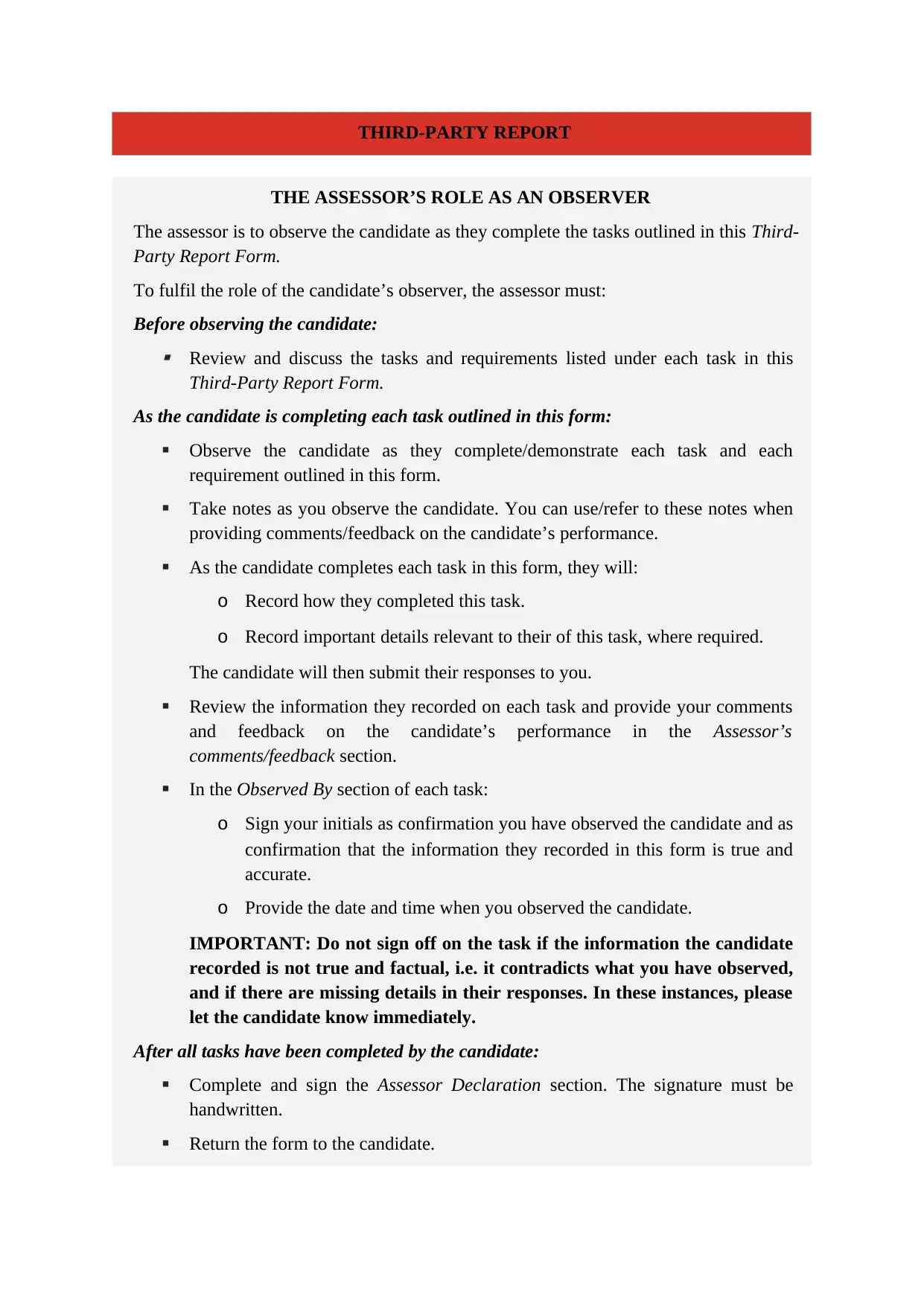
THIRD-PARTY REPORT
THE ASSESSOR’S ROLE AS AN OBSERVER
The assessor is to observe the candidate as they complete the tasks outlined in this Third-
Party Report Form.
To fulfil the role of the candidate’s observer, the assessor must:
Before observing the candidate: Review and discuss the tasks and requirements listed under each task in this
Third-Party Report Form.
As the candidate is completing each task outlined in this form:
Observe the candidate as they complete/demonstrate each task and each
requirement outlined in this form.
Take notes as you observe the candidate. You can use/refer to these notes when
providing comments/feedback on the candidate’s performance.
As the candidate completes each task in this form, they will:
o Record how they completed this task.
o Record important details relevant to their of this task, where required.
The candidate will then submit their responses to you.
Review the information they recorded on each task and provide your comments
and feedback on the candidate’s performance in the Assessor’s
comments/feedback section.
In the Observed By section of each task:
o Sign your initials as confirmation you have observed the candidate and as
confirmation that the information they recorded in this form is true and
accurate.
o Provide the date and time when you observed the candidate.
IMPORTANT: Do not sign off on the task if the information the candidate
recorded is not true and factual, i.e. it contradicts what you have observed,
and if there are missing details in their responses. In these instances, please
let the candidate know immediately.
After all tasks have been completed by the candidate:
Complete and sign the Assessor Declaration section. The signature must be
handwritten.
Return the form to the candidate.
THE ASSESSOR’S ROLE AS AN OBSERVER
The assessor is to observe the candidate as they complete the tasks outlined in this Third-
Party Report Form.
To fulfil the role of the candidate’s observer, the assessor must:
Before observing the candidate: Review and discuss the tasks and requirements listed under each task in this
Third-Party Report Form.
As the candidate is completing each task outlined in this form:
Observe the candidate as they complete/demonstrate each task and each
requirement outlined in this form.
Take notes as you observe the candidate. You can use/refer to these notes when
providing comments/feedback on the candidate’s performance.
As the candidate completes each task in this form, they will:
o Record how they completed this task.
o Record important details relevant to their of this task, where required.
The candidate will then submit their responses to you.
Review the information they recorded on each task and provide your comments
and feedback on the candidate’s performance in the Assessor’s
comments/feedback section.
In the Observed By section of each task:
o Sign your initials as confirmation you have observed the candidate and as
confirmation that the information they recorded in this form is true and
accurate.
o Provide the date and time when you observed the candidate.
IMPORTANT: Do not sign off on the task if the information the candidate
recorded is not true and factual, i.e. it contradicts what you have observed,
and if there are missing details in their responses. In these instances, please
let the candidate know immediately.
After all tasks have been completed by the candidate:
Complete and sign the Assessor Declaration section. The signature must be
handwritten.
Return the form to the candidate.
Paraphrase This Document
Need a fresh take? Get an instant paraphrase of this document with our AI Paraphraser

TO THE CANDIDATE
The following outlines workplace tasks relevant to developing positive and respectful
relationships with children while being observed by your assessor in the centre.
Complete each task outlined in this Third-Party Report Form while being observed by
your assessor. Your assessor will record important details from their observations in this
form.
TO THE ASSESSOR
By signing in the Observed by sections of each task, you are testifying that you have
sufficiently observed the candidate complete the task as recorded in this Third-Party
Report Form. You are also confirming that they have completed the task in accordance
with their work role and responsibilities, organisational policies and procedures,
relevant legal and regulatory requirements, and industry standards.
Candidate Details
Candidate name
Title/designation
Workplace/organisation
Observation Details
Date of observation
Time of observation
Location
Observed by
The following outlines workplace tasks relevant to developing positive and respectful
relationships with children while being observed by your assessor in the centre.
Complete each task outlined in this Third-Party Report Form while being observed by
your assessor. Your assessor will record important details from their observations in this
form.
TO THE ASSESSOR
By signing in the Observed by sections of each task, you are testifying that you have
sufficiently observed the candidate complete the task as recorded in this Third-Party
Report Form. You are also confirming that they have completed the task in accordance
with their work role and responsibilities, organisational policies and procedures,
relevant legal and regulatory requirements, and industry standards.
Candidate Details
Candidate name
Title/designation
Workplace/organisation
Observation Details
Date of observation
Time of observation
Location
Observed by
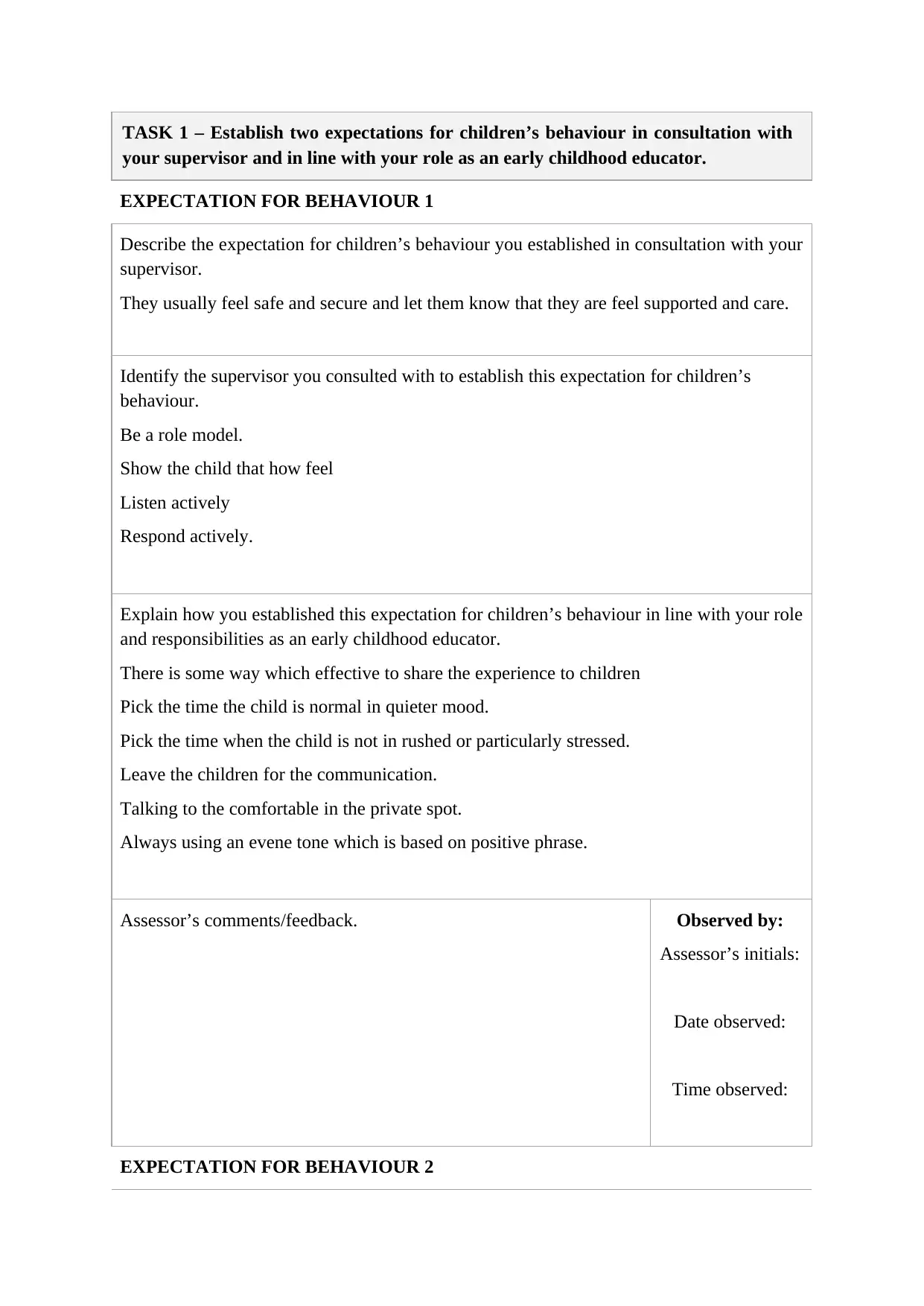
TASK 1 – Establish two expectations for children’s behaviour in consultation with
your supervisor and in line with your role as an early childhood educator.
EXPECTATION FOR BEHAVIOUR 1
Describe the expectation for children’s behaviour you established in consultation with your
supervisor.
They usually feel safe and secure and let them know that they are feel supported and care.
Identify the supervisor you consulted with to establish this expectation for children’s
behaviour.
Be a role model.
Show the child that how feel
Listen actively
Respond actively.
Explain how you established this expectation for children’s behaviour in line with your role
and responsibilities as an early childhood educator.
There is some way which effective to share the experience to children
Pick the time the child is normal in quieter mood.
Pick the time when the child is not in rushed or particularly stressed.
Leave the children for the communication.
Talking to the comfortable in the private spot.
Always using an evene tone which is based on positive phrase.
Assessor’s comments/feedback. Observed by:
Assessor’s initials:
Date observed:
Time observed:
EXPECTATION FOR BEHAVIOUR 2
your supervisor and in line with your role as an early childhood educator.
EXPECTATION FOR BEHAVIOUR 1
Describe the expectation for children’s behaviour you established in consultation with your
supervisor.
They usually feel safe and secure and let them know that they are feel supported and care.
Identify the supervisor you consulted with to establish this expectation for children’s
behaviour.
Be a role model.
Show the child that how feel
Listen actively
Respond actively.
Explain how you established this expectation for children’s behaviour in line with your role
and responsibilities as an early childhood educator.
There is some way which effective to share the experience to children
Pick the time the child is normal in quieter mood.
Pick the time when the child is not in rushed or particularly stressed.
Leave the children for the communication.
Talking to the comfortable in the private spot.
Always using an evene tone which is based on positive phrase.
Assessor’s comments/feedback. Observed by:
Assessor’s initials:
Date observed:
Time observed:
EXPECTATION FOR BEHAVIOUR 2
⊘ This is a preview!⊘
Do you want full access?
Subscribe today to unlock all pages.

Trusted by 1+ million students worldwide
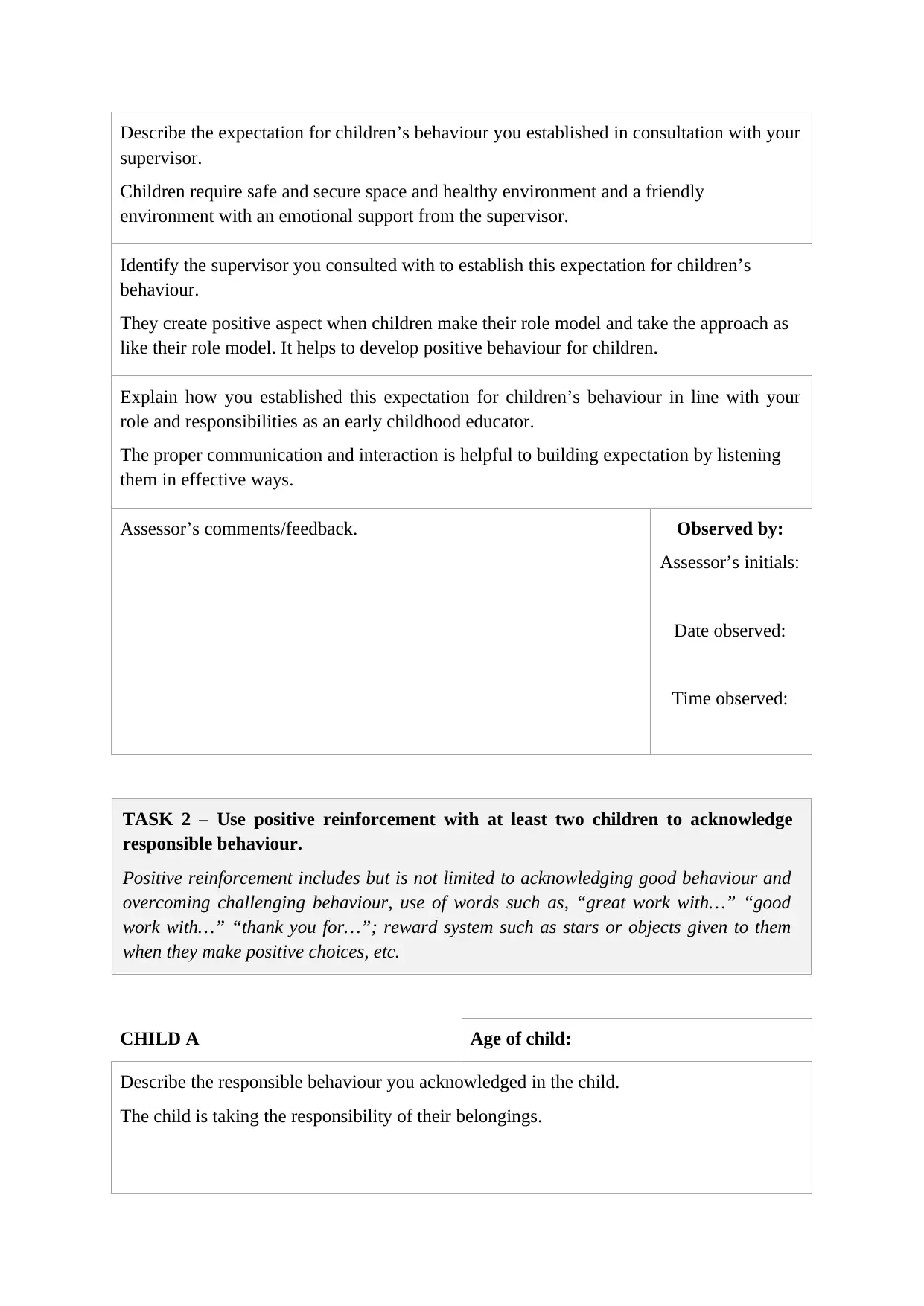
Describe the expectation for children’s behaviour you established in consultation with your
supervisor.
Children require safe and secure space and healthy environment and a friendly
environment with an emotional support from the supervisor.
Identify the supervisor you consulted with to establish this expectation for children’s
behaviour.
They create positive aspect when children make their role model and take the approach as
like their role model. It helps to develop positive behaviour for children.
Explain how you established this expectation for children’s behaviour in line with your
role and responsibilities as an early childhood educator.
The proper communication and interaction is helpful to building expectation by listening
them in effective ways.
Assessor’s comments/feedback. Observed by:
Assessor’s initials:
Date observed:
Time observed:
TASK 2 – Use positive reinforcement with at least two children to acknowledge
responsible behaviour.
Positive reinforcement includes but is not limited to acknowledging good behaviour and
overcoming challenging behaviour, use of words such as, “great work with…” “good
work with…” “thank you for…”; reward system such as stars or objects given to them
when they make positive choices, etc.
CHILD A Age of child:
Describe the responsible behaviour you acknowledged in the child.
The child is taking the responsibility of their belongings.
supervisor.
Children require safe and secure space and healthy environment and a friendly
environment with an emotional support from the supervisor.
Identify the supervisor you consulted with to establish this expectation for children’s
behaviour.
They create positive aspect when children make their role model and take the approach as
like their role model. It helps to develop positive behaviour for children.
Explain how you established this expectation for children’s behaviour in line with your
role and responsibilities as an early childhood educator.
The proper communication and interaction is helpful to building expectation by listening
them in effective ways.
Assessor’s comments/feedback. Observed by:
Assessor’s initials:
Date observed:
Time observed:
TASK 2 – Use positive reinforcement with at least two children to acknowledge
responsible behaviour.
Positive reinforcement includes but is not limited to acknowledging good behaviour and
overcoming challenging behaviour, use of words such as, “great work with…” “good
work with…” “thank you for…”; reward system such as stars or objects given to them
when they make positive choices, etc.
CHILD A Age of child:
Describe the responsible behaviour you acknowledged in the child.
The child is taking the responsibility of their belongings.
Paraphrase This Document
Need a fresh take? Get an instant paraphrase of this document with our AI Paraphraser
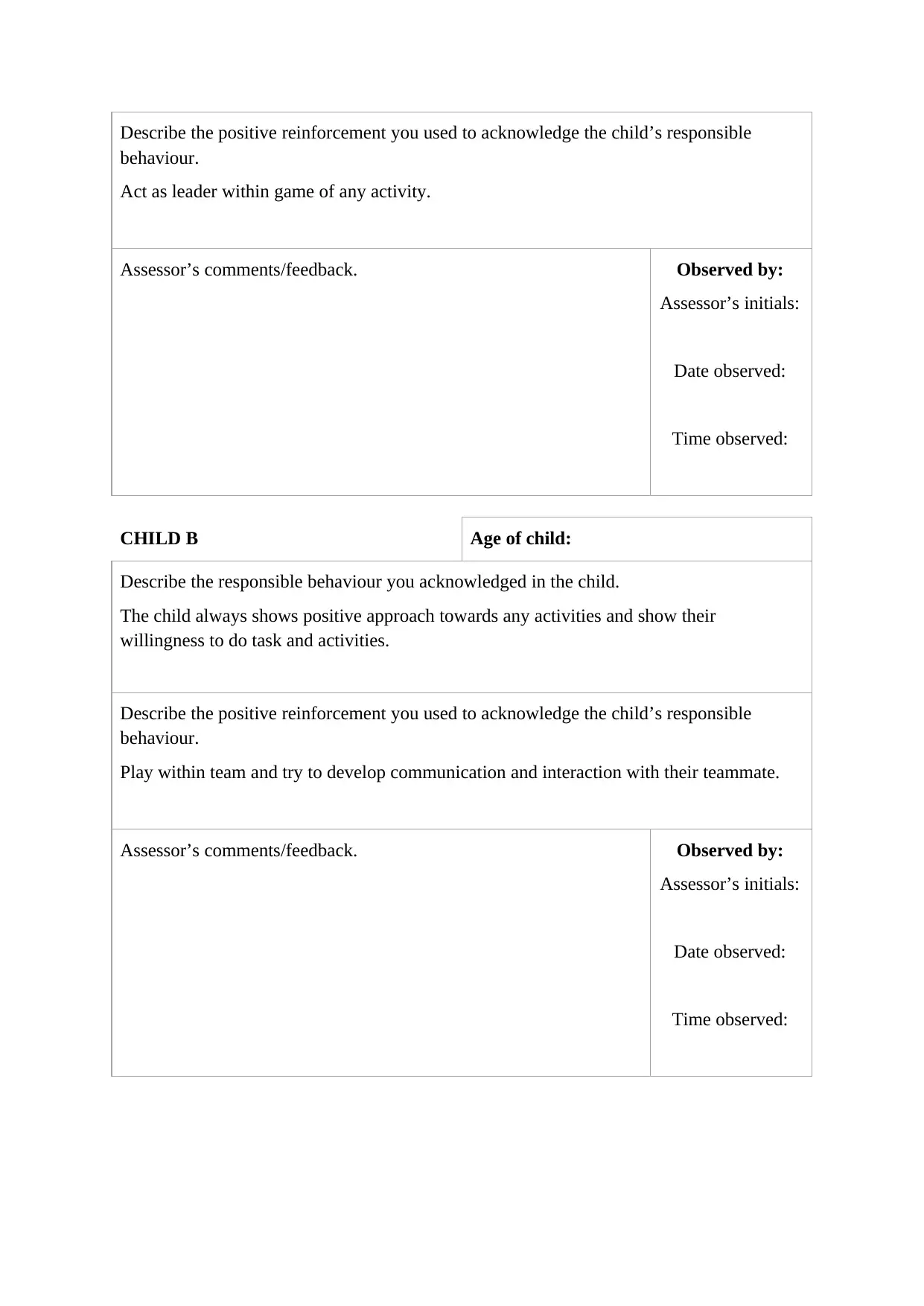
Describe the positive reinforcement you used to acknowledge the child’s responsible
behaviour.
Act as leader within game of any activity.
Assessor’s comments/feedback. Observed by:
Assessor’s initials:
Date observed:
Time observed:
CHILD B Age of child:
Describe the responsible behaviour you acknowledged in the child.
The child always shows positive approach towards any activities and show their
willingness to do task and activities.
Describe the positive reinforcement you used to acknowledge the child’s responsible
behaviour.
Play within team and try to develop communication and interaction with their teammate.
Assessor’s comments/feedback. Observed by:
Assessor’s initials:
Date observed:
Time observed:
behaviour.
Act as leader within game of any activity.
Assessor’s comments/feedback. Observed by:
Assessor’s initials:
Date observed:
Time observed:
CHILD B Age of child:
Describe the responsible behaviour you acknowledged in the child.
The child always shows positive approach towards any activities and show their
willingness to do task and activities.
Describe the positive reinforcement you used to acknowledge the child’s responsible
behaviour.
Play within team and try to develop communication and interaction with their teammate.
Assessor’s comments/feedback. Observed by:
Assessor’s initials:
Date observed:
Time observed:
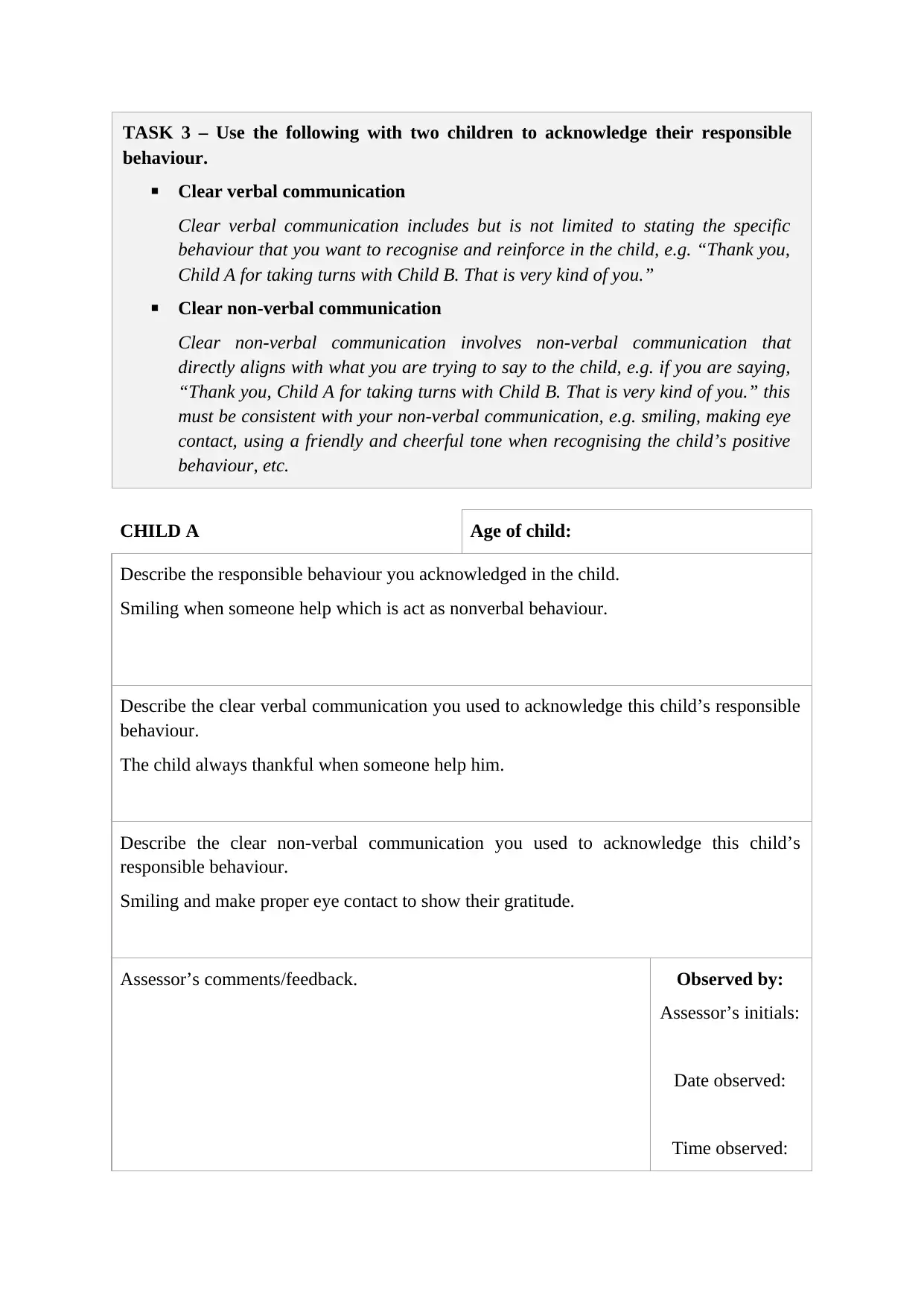
TASK 3 – Use the following with two children to acknowledge their responsible
behaviour.
Clear verbal communication
Clear verbal communication includes but is not limited to stating the specific
behaviour that you want to recognise and reinforce in the child, e.g. “Thank you,
Child A for taking turns with Child B. That is very kind of you.”
Clear non-verbal communication
Clear non-verbal communication involves non-verbal communication that
directly aligns with what you are trying to say to the child, e.g. if you are saying,
“Thank you, Child A for taking turns with Child B. That is very kind of you.” this
must be consistent with your non-verbal communication, e.g. smiling, making eye
contact, using a friendly and cheerful tone when recognising the child’s positive
behaviour, etc.
CHILD A Age of child:
Describe the responsible behaviour you acknowledged in the child.
Smiling when someone help which is act as nonverbal behaviour.
Describe the clear verbal communication you used to acknowledge this child’s responsible
behaviour.
The child always thankful when someone help him.
Describe the clear non-verbal communication you used to acknowledge this child’s
responsible behaviour.
Smiling and make proper eye contact to show their gratitude.
Assessor’s comments/feedback. Observed by:
Assessor’s initials:
Date observed:
Time observed:
behaviour.
Clear verbal communication
Clear verbal communication includes but is not limited to stating the specific
behaviour that you want to recognise and reinforce in the child, e.g. “Thank you,
Child A for taking turns with Child B. That is very kind of you.”
Clear non-verbal communication
Clear non-verbal communication involves non-verbal communication that
directly aligns with what you are trying to say to the child, e.g. if you are saying,
“Thank you, Child A for taking turns with Child B. That is very kind of you.” this
must be consistent with your non-verbal communication, e.g. smiling, making eye
contact, using a friendly and cheerful tone when recognising the child’s positive
behaviour, etc.
CHILD A Age of child:
Describe the responsible behaviour you acknowledged in the child.
Smiling when someone help which is act as nonverbal behaviour.
Describe the clear verbal communication you used to acknowledge this child’s responsible
behaviour.
The child always thankful when someone help him.
Describe the clear non-verbal communication you used to acknowledge this child’s
responsible behaviour.
Smiling and make proper eye contact to show their gratitude.
Assessor’s comments/feedback. Observed by:
Assessor’s initials:
Date observed:
Time observed:
⊘ This is a preview!⊘
Do you want full access?
Subscribe today to unlock all pages.

Trusted by 1+ million students worldwide

Paraphrase This Document
Need a fresh take? Get an instant paraphrase of this document with our AI Paraphraser

CHILD B Age of child:
Describe the responsible behaviour you acknowledged in the child.
The child always makes proper communication while saying thank you.
Describe the clear verbal communication you used to acknowledge this child’s responsible
behaviour.
They treat other with their positive gesture and say thank you and welcome that indicate
their capability.
Describe the clear non-verbal communication you used to acknowledge this child’s
responsible behaviour.
Smiling face.
Assessor’s comments/feedback. Observed by:
Assessor’s initials:
Date observed:
Time observed:
TASK 4 – Use at least one appropriate strategy to redirect the challenging
behaviour of two children.
CHILD A Age of child: 2
Describe the challenging behaviour you redirected in this instance.
Try to walk properly and make interaction with people while making eye contact.
Describe the responsible behaviour you acknowledged in the child.
The child always makes proper communication while saying thank you.
Describe the clear verbal communication you used to acknowledge this child’s responsible
behaviour.
They treat other with their positive gesture and say thank you and welcome that indicate
their capability.
Describe the clear non-verbal communication you used to acknowledge this child’s
responsible behaviour.
Smiling face.
Assessor’s comments/feedback. Observed by:
Assessor’s initials:
Date observed:
Time observed:
TASK 4 – Use at least one appropriate strategy to redirect the challenging
behaviour of two children.
CHILD A Age of child: 2
Describe the challenging behaviour you redirected in this instance.
Try to walk properly and make interaction with people while making eye contact.
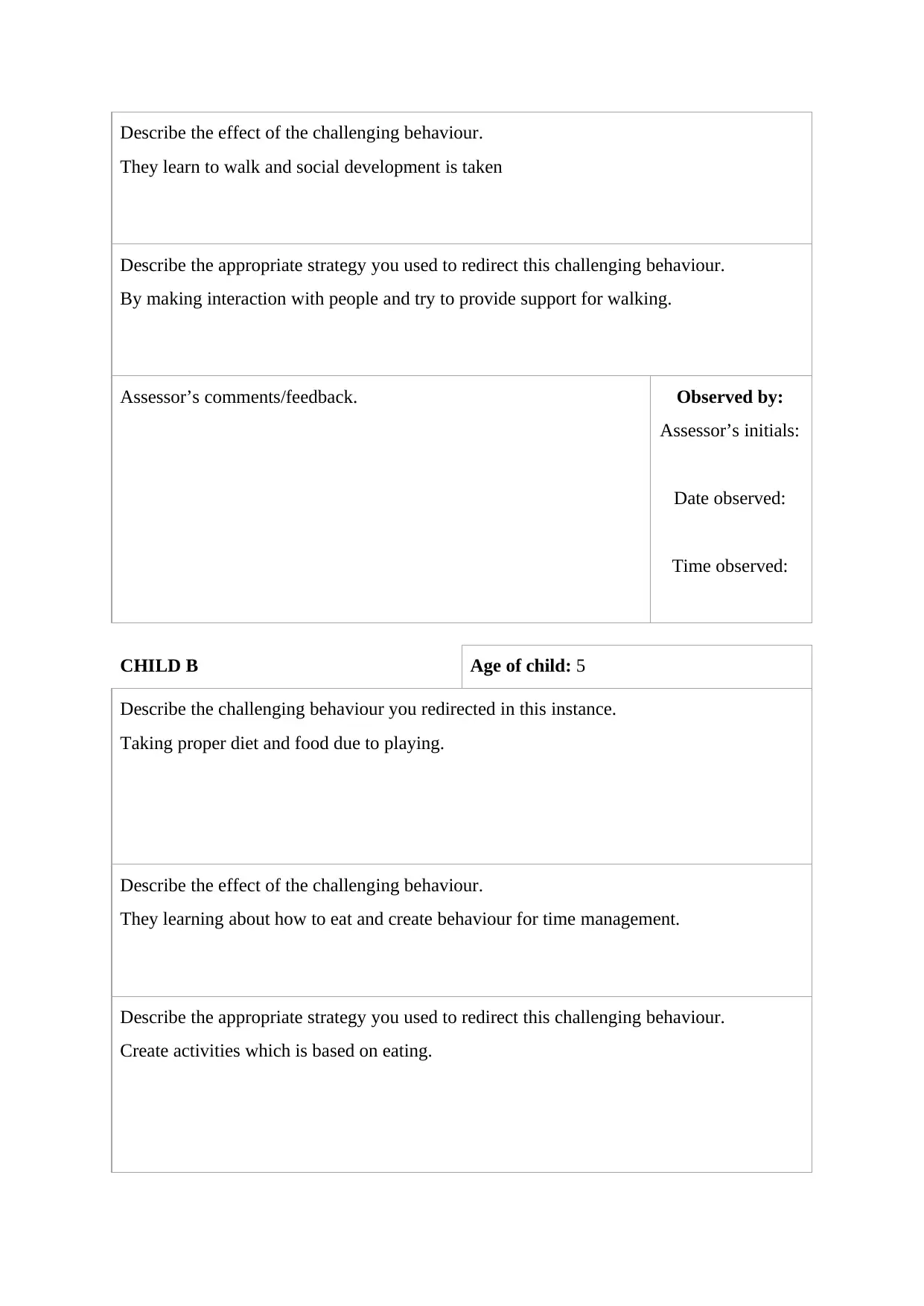
Describe the effect of the challenging behaviour.
They learn to walk and social development is taken
Describe the appropriate strategy you used to redirect this challenging behaviour.
By making interaction with people and try to provide support for walking.
Assessor’s comments/feedback. Observed by:
Assessor’s initials:
Date observed:
Time observed:
CHILD B Age of child: 5
Describe the challenging behaviour you redirected in this instance.
Taking proper diet and food due to playing.
Describe the effect of the challenging behaviour.
They learning about how to eat and create behaviour for time management.
Describe the appropriate strategy you used to redirect this challenging behaviour.
Create activities which is based on eating.
They learn to walk and social development is taken
Describe the appropriate strategy you used to redirect this challenging behaviour.
By making interaction with people and try to provide support for walking.
Assessor’s comments/feedback. Observed by:
Assessor’s initials:
Date observed:
Time observed:
CHILD B Age of child: 5
Describe the challenging behaviour you redirected in this instance.
Taking proper diet and food due to playing.
Describe the effect of the challenging behaviour.
They learning about how to eat and create behaviour for time management.
Describe the appropriate strategy you used to redirect this challenging behaviour.
Create activities which is based on eating.
⊘ This is a preview!⊘
Do you want full access?
Subscribe today to unlock all pages.

Trusted by 1+ million students worldwide
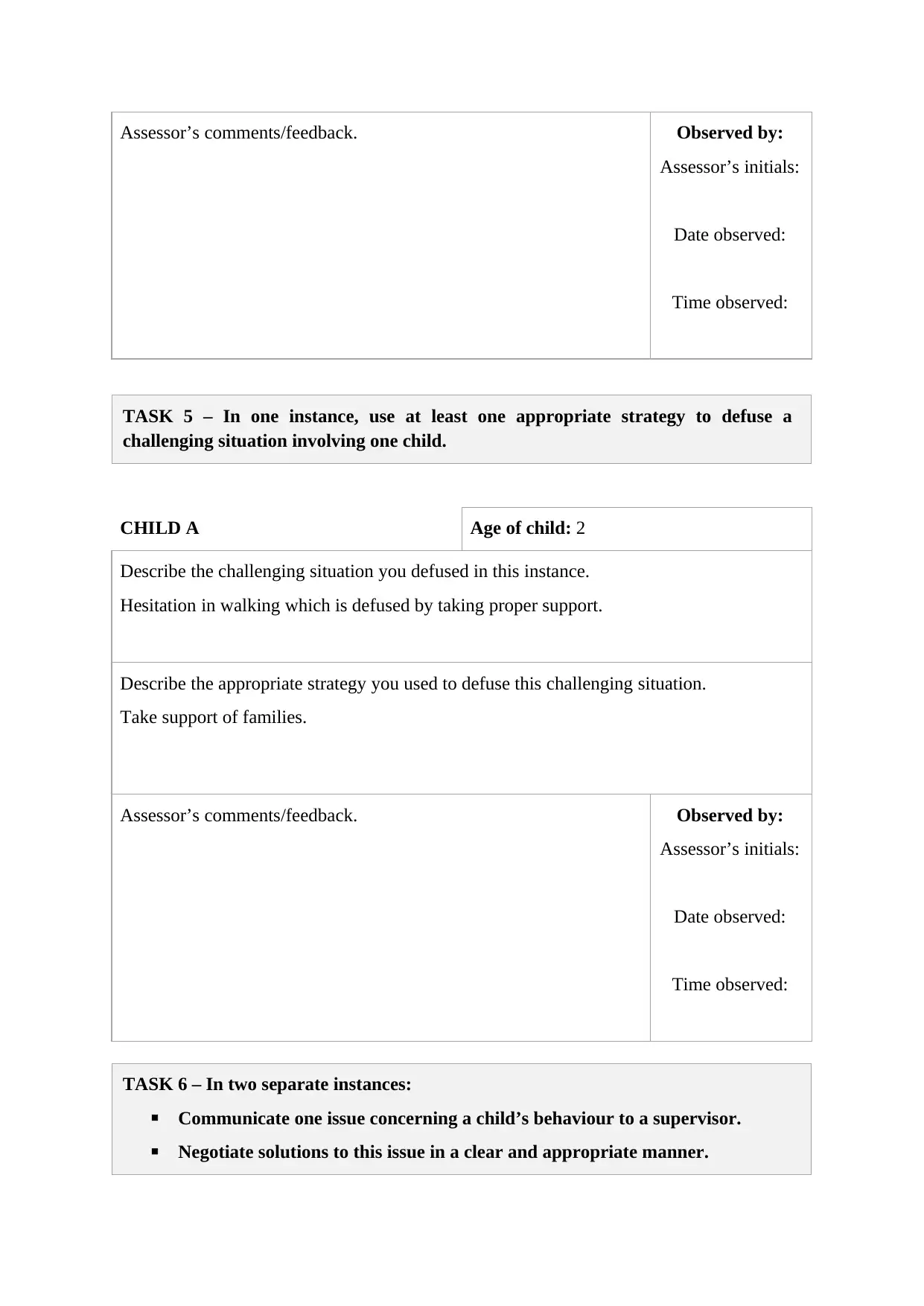
Assessor’s comments/feedback. Observed by:
Assessor’s initials:
Date observed:
Time observed:
TASK 5 – In one instance, use at least one appropriate strategy to defuse a
challenging situation involving one child.
CHILD A Age of child: 2
Describe the challenging situation you defused in this instance.
Hesitation in walking which is defused by taking proper support.
Describe the appropriate strategy you used to defuse this challenging situation.
Take support of families.
Assessor’s comments/feedback. Observed by:
Assessor’s initials:
Date observed:
Time observed:
TASK 6 – In two separate instances:
Communicate one issue concerning a child’s behaviour to a supervisor.
Negotiate solutions to this issue in a clear and appropriate manner.
Assessor’s initials:
Date observed:
Time observed:
TASK 5 – In one instance, use at least one appropriate strategy to defuse a
challenging situation involving one child.
CHILD A Age of child: 2
Describe the challenging situation you defused in this instance.
Hesitation in walking which is defused by taking proper support.
Describe the appropriate strategy you used to defuse this challenging situation.
Take support of families.
Assessor’s comments/feedback. Observed by:
Assessor’s initials:
Date observed:
Time observed:
TASK 6 – In two separate instances:
Communicate one issue concerning a child’s behaviour to a supervisor.
Negotiate solutions to this issue in a clear and appropriate manner.
Paraphrase This Document
Need a fresh take? Get an instant paraphrase of this document with our AI Paraphraser
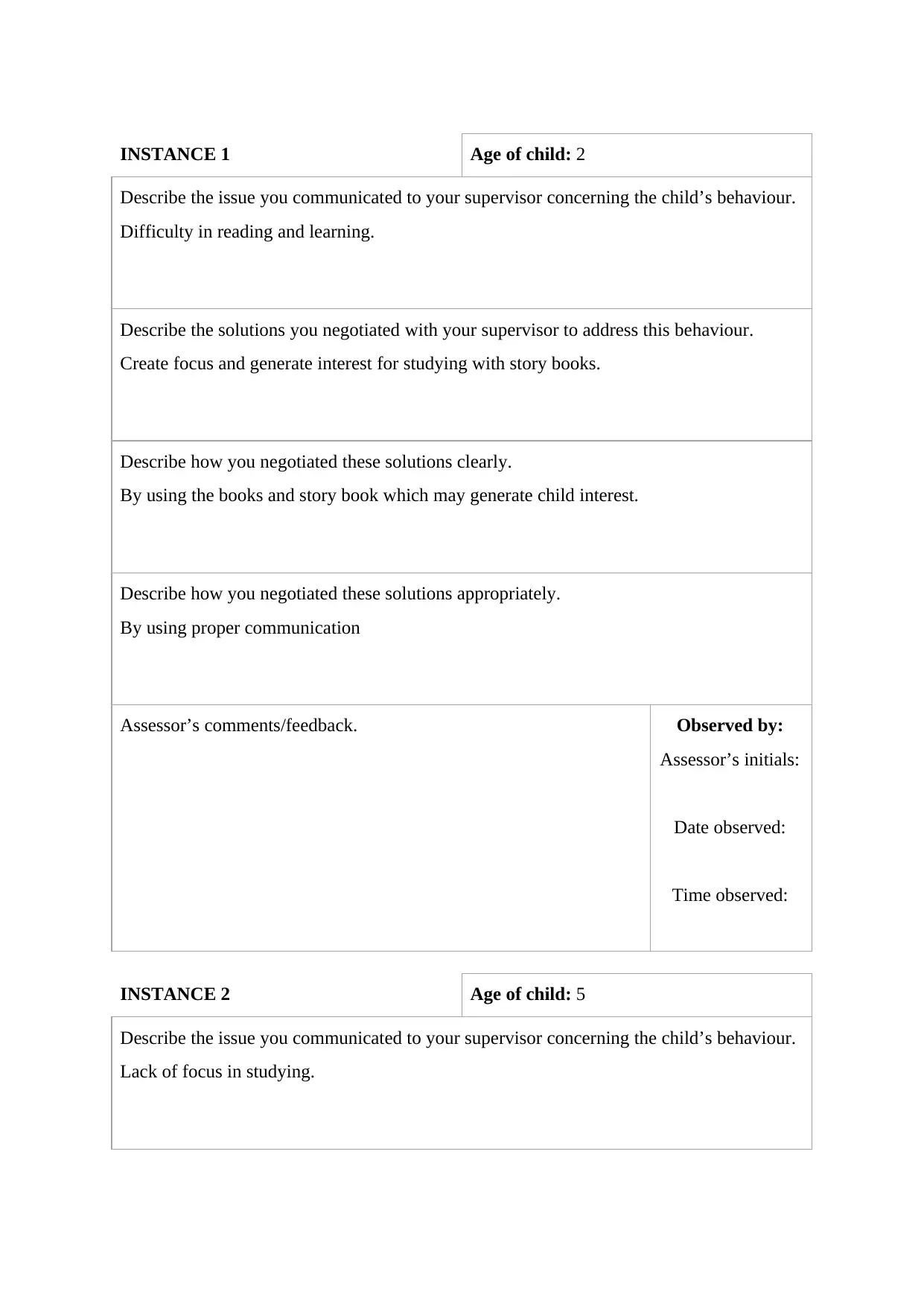
INSTANCE 1 Age of child: 2
Describe the issue you communicated to your supervisor concerning the child’s behaviour.
Difficulty in reading and learning.
Describe the solutions you negotiated with your supervisor to address this behaviour.
Create focus and generate interest for studying with story books.
Describe how you negotiated these solutions clearly.
By using the books and story book which may generate child interest.
Describe how you negotiated these solutions appropriately.
By using proper communication
Assessor’s comments/feedback. Observed by:
Assessor’s initials:
Date observed:
Time observed:
INSTANCE 2 Age of child: 5
Describe the issue you communicated to your supervisor concerning the child’s behaviour.
Lack of focus in studying.
Describe the issue you communicated to your supervisor concerning the child’s behaviour.
Difficulty in reading and learning.
Describe the solutions you negotiated with your supervisor to address this behaviour.
Create focus and generate interest for studying with story books.
Describe how you negotiated these solutions clearly.
By using the books and story book which may generate child interest.
Describe how you negotiated these solutions appropriately.
By using proper communication
Assessor’s comments/feedback. Observed by:
Assessor’s initials:
Date observed:
Time observed:
INSTANCE 2 Age of child: 5
Describe the issue you communicated to your supervisor concerning the child’s behaviour.
Lack of focus in studying.
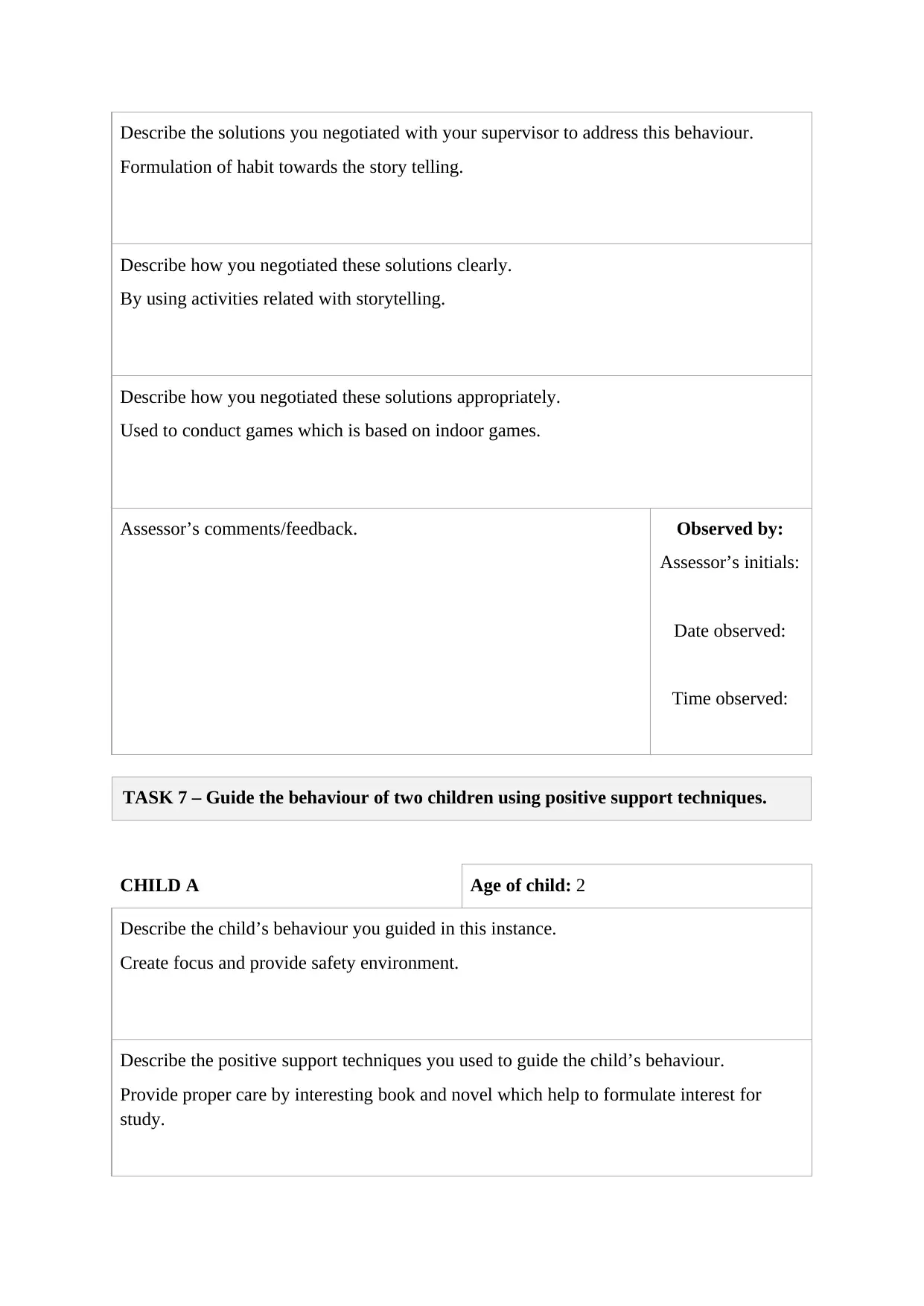
Describe the solutions you negotiated with your supervisor to address this behaviour.
Formulation of habit towards the story telling.
Describe how you negotiated these solutions clearly.
By using activities related with storytelling.
Describe how you negotiated these solutions appropriately.
Used to conduct games which is based on indoor games.
Assessor’s comments/feedback. Observed by:
Assessor’s initials:
Date observed:
Time observed:
TASK 7 – Guide the behaviour of two children using positive support techniques.
CHILD A Age of child: 2
Describe the child’s behaviour you guided in this instance.
Create focus and provide safety environment.
Describe the positive support techniques you used to guide the child’s behaviour.
Provide proper care by interesting book and novel which help to formulate interest for
study.
Formulation of habit towards the story telling.
Describe how you negotiated these solutions clearly.
By using activities related with storytelling.
Describe how you negotiated these solutions appropriately.
Used to conduct games which is based on indoor games.
Assessor’s comments/feedback. Observed by:
Assessor’s initials:
Date observed:
Time observed:
TASK 7 – Guide the behaviour of two children using positive support techniques.
CHILD A Age of child: 2
Describe the child’s behaviour you guided in this instance.
Create focus and provide safety environment.
Describe the positive support techniques you used to guide the child’s behaviour.
Provide proper care by interesting book and novel which help to formulate interest for
study.
⊘ This is a preview!⊘
Do you want full access?
Subscribe today to unlock all pages.

Trusted by 1+ million students worldwide
1 out of 16
Related Documents
Your All-in-One AI-Powered Toolkit for Academic Success.
+13062052269
info@desklib.com
Available 24*7 on WhatsApp / Email
![[object Object]](/_next/static/media/star-bottom.7253800d.svg)
Unlock your academic potential
Copyright © 2020–2025 A2Z Services. All Rights Reserved. Developed and managed by ZUCOL.




